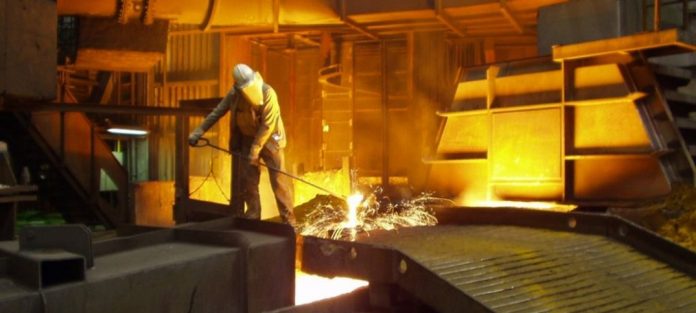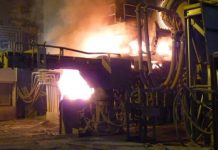The World Steel Association (worldsteel) released its Short Range Outlook (SRO) for 2019 and 2020.
In 2019 worldsteel forecasts that steel demand in China will grow by 7.8% to reach 900.1 Mt and the rest of the world is expected to record 0.2% growth to 874.9 Mt. In 2020, Chinese steel demand is expected to grow by 1.0%, whereas steel demand in the rest of the world will grow by 2.5%, driven by 4.1% growth in the emerging and developing economies excluding China. Global steel demand will grow by 3.9% to 1,775.0 Mt in 2019 and will grow by another 1.7% in 2020, reaching 1,805.7 Mt.
Global steel demand remains resilient despite an uncertain global economic environment, driven by developing and emerging economies
Commenting on the outlook, Mr Al Remeithi, Chairman of the worldsteel Economics Committee said: “The current SRO suggests that global steel demand will continue to grow in 2019, more than we expected in these challenging times, mainly due to China. In the rest of the world, steel demand slowed in 2019 as uncertainty, trade tensions and geopolitical issues weighed on investment and trade. Manufacturing, particularly the auto industry, has performed poorly contracting in many countries, however in construction, despite some slowing, a positive momentum has been maintained. While the global economic outlook is highly unpredictable, we expect to see further growth in steel demand in 2020 of 1.7%, with emerging and developing economies excluding China contributing more. This forecast faces significant downside risks if the current level of uncertainty prevails.”
Chinese steel demand showing high growth in 2019 owing to a strong real estate sector, but forecasted to slow down in 2020
While the Chinese economy continued to decelerate and is expected to record its lowest GDP growth since 1992, steel demand is still expected to grow by 7.8% in 2019, largely driven by real estate investment. In the first seven months of 2019 China’s real estate market reported the strongest performance over the same period for the last five years. Firstly, due to the relaxation of control policies in tier 2 to tier 4 cities and secondly the newly implemented construction standard, put into effect in April 2019, estimated to have increased steel intensity in new buildings by about 5.0%.
Conversely, China’s manufacturing sector is experiencing a significant slump due to the slowing economy and the effect of trade tensions. The Chinese automotive industry has contracted for 13 months in a row. We expect the Chinese economy to worsen in the later part of 2019 and in 2020 with the unresolved trade tensions adding further pressure. It is unlikely that the Chinese government will reintroduce substantial stimulus measures as it continues to hold a balance between containing the slowdown and pushing forward its economic restructuring agenda. Selective mild stimuli focused on infrastructure and strengthening consumer purchasing power through tax cuts is more likely. The auto industry could benefit from such stimulus in 2020. China’s steel demand is expected to see growth of 1.0% in 2020.
*Note: The statistical issues reported by worldsteel in previous SROs relating to the closure of induction furnaces and the consequent underreporting of demand in official figures will have now largely played through the system. However, it is believed that some degree of underreporting from 2018 could still affect the 2019 growth rate. Due to this effect, while nominal growth points to 7.8% in 2019, worldsteel estimates real growth to be 4.0%.
Steel demand in the developed world stagnates with weakening manufacturing
After growing by 1.2% in 2018, steel demand in the developed economies is expected to show a small contraction of -0.1% in 2019. The consumer sectors and construction maintained positive momentum, however manufacturing slumped due to a deteriorating environment for export and investment. In 2020, with the effect of some technical rebound, steel demand in the developed world is expected to grow by 0.6%.
Developing economies (excluding China) present a mixed picture, but high growth is expected in Asia
Growth of steel demand in the emerging economies excluding China is expected to slow down to 0.4% in 2019 due to contractions in Turkey, MENA and Latin America. But the growth is expected to rebound to 4.1% in 2020 due to infrastructure investments, especially in Asia.
Construction
The global construction sector’s growth is expected to slow to 1.5% in 2019 and 1.2% in 2020 after growth of 2.8% in 2018. The picture for construction activity in the developed economies in 2019-2020 is somewhat mixed. The US construction sector is expected to weaken in 2019 with no recovery in 2020. In Europe, the construction sectors in Germany, Spain, the Netherlands and Central European economies, while still maintaining growth, will slow down due to weakening economic fundamentals and constraints in construction capacity. Civil engineering is expected to be the construction driver owing to investment in energy, transport and communication networks.
The Japanese construction sector is projected to report almost no growth as the decline in residential construction will be offset by growth in civil engineering. Korea’s construction sector is expected to continue contracting despite some support from public projects. Construction in emerging markets will be strong, largely influenced by infrastructure projects. In China, the real estate sector drove growth in construction activity in 2019, but in 2020 this will slow down. Infrastructure investment is expected to be boosted by government stimulus. In ASEAN and India, active infrastructure investment is expected to drive construction.
Turkey has seen contracting construction activity in line with the overall economy. After a severe decline in 2019, Turkey will see only a moderate rebound in 2020. In Latin America generally, infrastructure investment is constrained by uncertainty and government budget issues. Brazil’s construction sector, which has been contracting since 2014, has shown positive growth in 2019 and this could continue with infrastructure a policy priority.
Automotive
Global automotive production decelerated in 2018 and is expected to contract in 2019 with recession deepening and broadening across several major markets including Germany, Turkey, China and South Korea. The automotive market has been hit by more than global economic factors including, market saturation, reduction in purchasing and promotion incentives and most importantly customer hesitancy during the transition of the auto industry from combustion engine-powered via hybrid to fully electric vehicles.
This decline has been particularly severe in Germany and China with passenger car production declining by -10.6% and -13.8%, respectively in the first eight months of 2019. It is expected that the Chinese government may introduce some tax measures to boost sales of passenger vehicles, especially new energy vehicles. This could lead to a recovery in 2020.
In the US, the auto market is expected to decelerate with no growth in 2019 and only a slight increase in 2020, but steel use is expected to benefit from the shift toward light truck models. Japanese and Korean car production is being affected by weak export markets. The Indian automotive industry suffered from the liquidity crisis and weak global demand to show almost no growth in 2019, but it is expected to pick up in 2020 before the introduction of stringent pollution standards in April 2020. The Turkish auto industry continues to struggle with contraction in both domestic and export markets. In Brazil and Mexico, auto production maintained positive but slowing growth in 2019.
Mechanical machinery
After strong growth in 2017-18, global mechanical machinery is expected to decelerate to remain flat in 2019-20 as the deceleration of the global economy and continuation of trade tensions hurt global investment activities.
The mechanical machinery output in major exporters – China, Germany and Japan – is expected to keep falling in 2020. The Chinese mechanical machinery sector is expected to decline by -1.0% in 2019, even though the replacement demand for equipment will provide some support in 2019 and 2020.
General-purpose machinery, including energy related machinery, will positively contribute to the sector’s growth. On the other hand, construction machinery is expected to decline in 2019 and 2020, but the decline will be partially offset by the demand deriving from expansion of infrastructure projects in developing countries.
Source: World Steel Association






